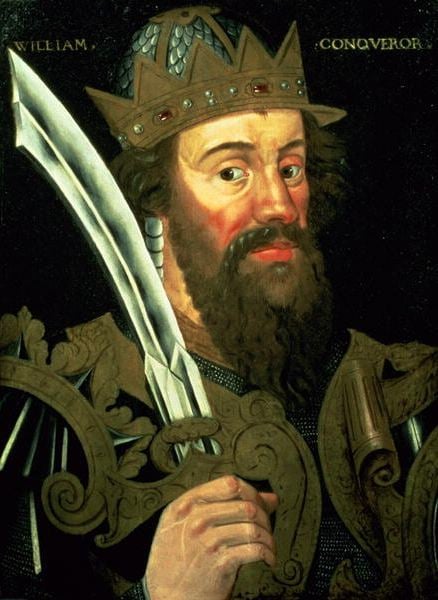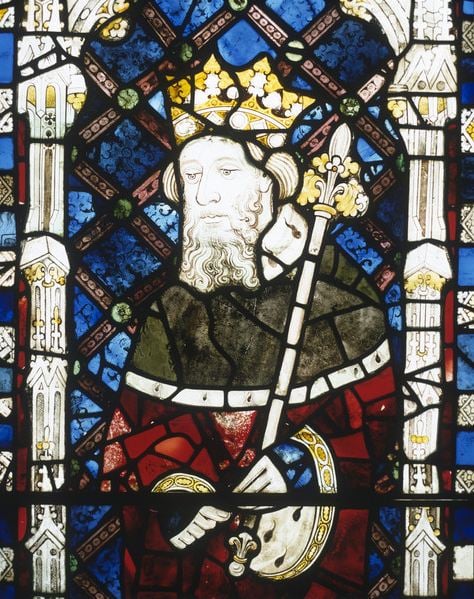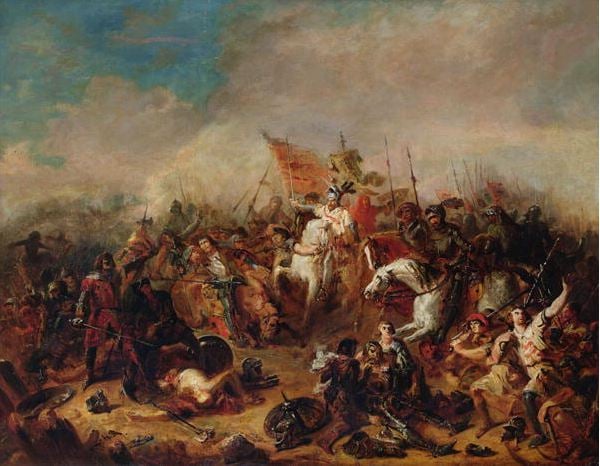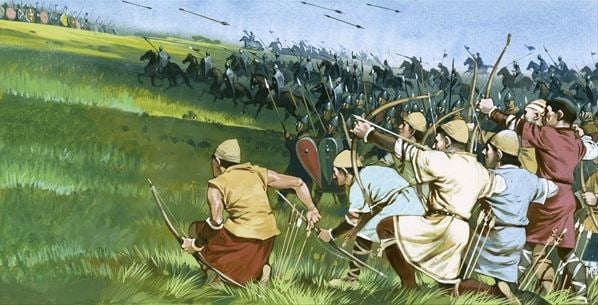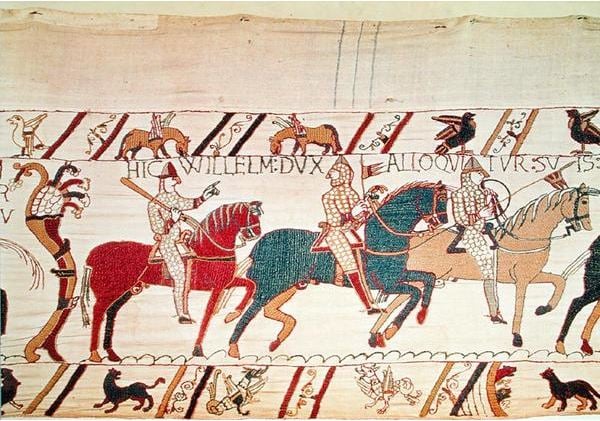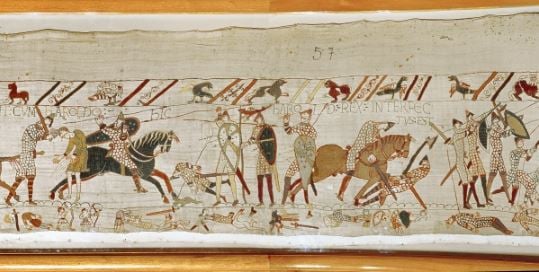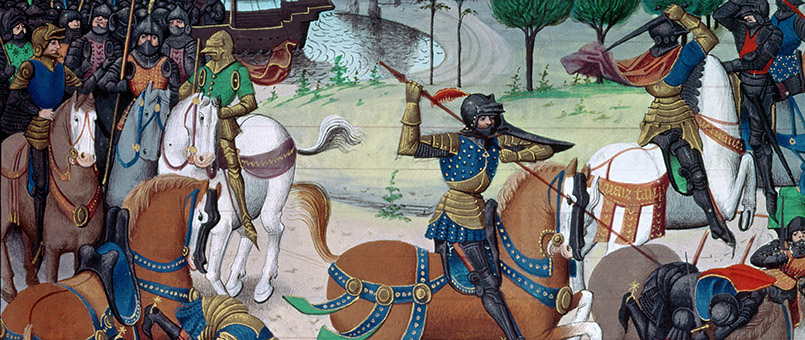
The Battle of Hastings: 950 years
The legendary Battle of Hastings was fought on 14 October 1066 between the Norman-French army of Duke William II of Normandy and an English army under the Anglo-Saxon King Harold Godwinson, beginning the Norman conquest of England. It was a decisive Norman victory.
October 2016 will be the 950th anniversary of the epic battle that changed the course of history forever. To mark the occasion, uncover facts about the event that you may not have known before.
Portrait of William the Conqueror (1027-87), English School, (16th century) / Private Collection / Photo © Philip Mould Ltd, London
Window depicting King Harold, from the Great West Window (stained glass), English School, (15th century) / Canterbury Cathedral, Kent, UK / Sonia Halliday Photographs
All in a day’s work
Remarkably, the entire battle was fought and won in a day, beginning at around 9am and ending at dusk. Both sides even took a break for lunch…
The Battle of Hastings in 1066, Francois Hippolyte Debon (1807-72) / Musee des Beaux-Arts, Caen, France
Location, location, location
Despite its name, the Battle of Hastings actually took place roughly 6.5 miles northwest of Hastings, close to the present day town of Battle in East Sussex. Battle is home to Battle Abbey, which William founded as penance for all of the bloodshed.
Let’s talk tactics
It wasn’t really a fairly fought battle – most of the English army were on foot, supported by a few archers, while about a quarter of the Norman army were on horses and were supported by many archers.
Battle of Hastings , Angus McBride (1931-2007) / Private Collection / © Look and Learn
Harold seems to have tried to surprise William, but scouts found his army and reported its arrival to William. The Normans were more cunning – they pretended to flee in panic and then turned on their pursuers, who had subsquently left their flanks exposed to attack.
The Bayeux Tapestry
This famous embroidered cloth is nearly 70 metres long and 50 centimetres tall and depicts the events leading up to the Norman conquest of England. It consists of about fifty scenes with Latin inscriptions, embroidered on linen with coloured woollen yarns.
Duke William exhorts his troops to prepare themselves for the battle against the English army, detail from the Bayeux Tapestry, before 1082 (wool embroidery on linen), French School, (11th century) / Musée de la Tapisserie, Bayeux, France / With special authorisation of the city of Bayeux
Funnily enough, the tapestry is not technically a tapestry since it was embroidered rather than woven, nor was it made in Bayeux as it was likely commissioned by William’s half-brother, Bishop Odo, and made in England in the 1070s.
English and French soldiers fall side by side in the battle; Bishop Odo, holding a club, urges on the young soldiers, detail from the Bayeux Tapestry, before 1082 (wool embroidery on linen) / Musée de la Tapisserie, Bayeux, France
Alternatively, it is also sometimes referred to in France as the Tapestry of Queen Matilda as legend has it that William’s wife, Queen Matilda, and her ladies-in-waiting made it. Either way, the tapestry definitely comes from a Norman viewpoint; modern scholars believe it was created as an apologia or formal defence for the Norman Conquest.
“The Bayeux tapestry is one of the supreme achievements of the Norman Romanesque …. Its survival almost intact over nine centuries is little short of miraculous … Its exceptional length, the harmony and freshness of its colours, its exquisite workmanship, and the genius of its guiding spirit combine to make it endlessly fascinating.”
– Sylvette Lemagnen, conservator of the tapestry
1066 problems but an arrow in the eye ain’t one
Thanks to the Bayeux Tapestry, it is widely believed that King Harold died from an arrow in the eye and was then brutally dismembered by four Norman knights. In the Gesta Guillelmi, which was probably written between 1071 and 1077, William of Poitiers indicates that the dismembered body was so bloodied that “He himself was recognized by certain marks, not by his face, for he had been despoiled of all signs of status” (II.25).
However many historians are unsure as to whether the figure depicted is actually the King, particularly as no other historical documents refer to an arrow in his killing.
Many fall in battle and King Harold is killed, detail from the Bayeux Tapestry, before 1082 (wool embroidery on linen) / Musée de la Tapisserie, Bayeux, France / Bridgeman Images
It is not known what happened to Harold’s body either; one story states that Gytha, Harold’s mother, offered the victorious duke the weight of her son’s body in gold for its custody, but was refused. Other claims were that the body was thrown into the sea under William’s orders; that it was buried at the top of a cliff; or that it was secretly buried in Waltham Abbey.
In fact, some archaeologists even believe that he could have survived the battle and died as an 80-year old hermit in Chester. Conspiracy theorists, assemble!
William’s Legacy
Of course a lot of things were affected by William the Conqueror’s victory, but did you know that many genealogists believe that as much as 25% of the English population are descended from him?
French also became the language of the king’s court and this, blended with Anglo-Saxon English, eventually evolved into the English language as we know it today; hence many French words are used in our common speech.
Sources
Britain-magazine.com. 10 Facts about the Battle of Hastings 14 Oct 2015
Daily Mail. Was King Harold killed by an Arrow in the Eye? 12 Oct 2014
Penelope.uchicago.edu. The Death of King Harold.

